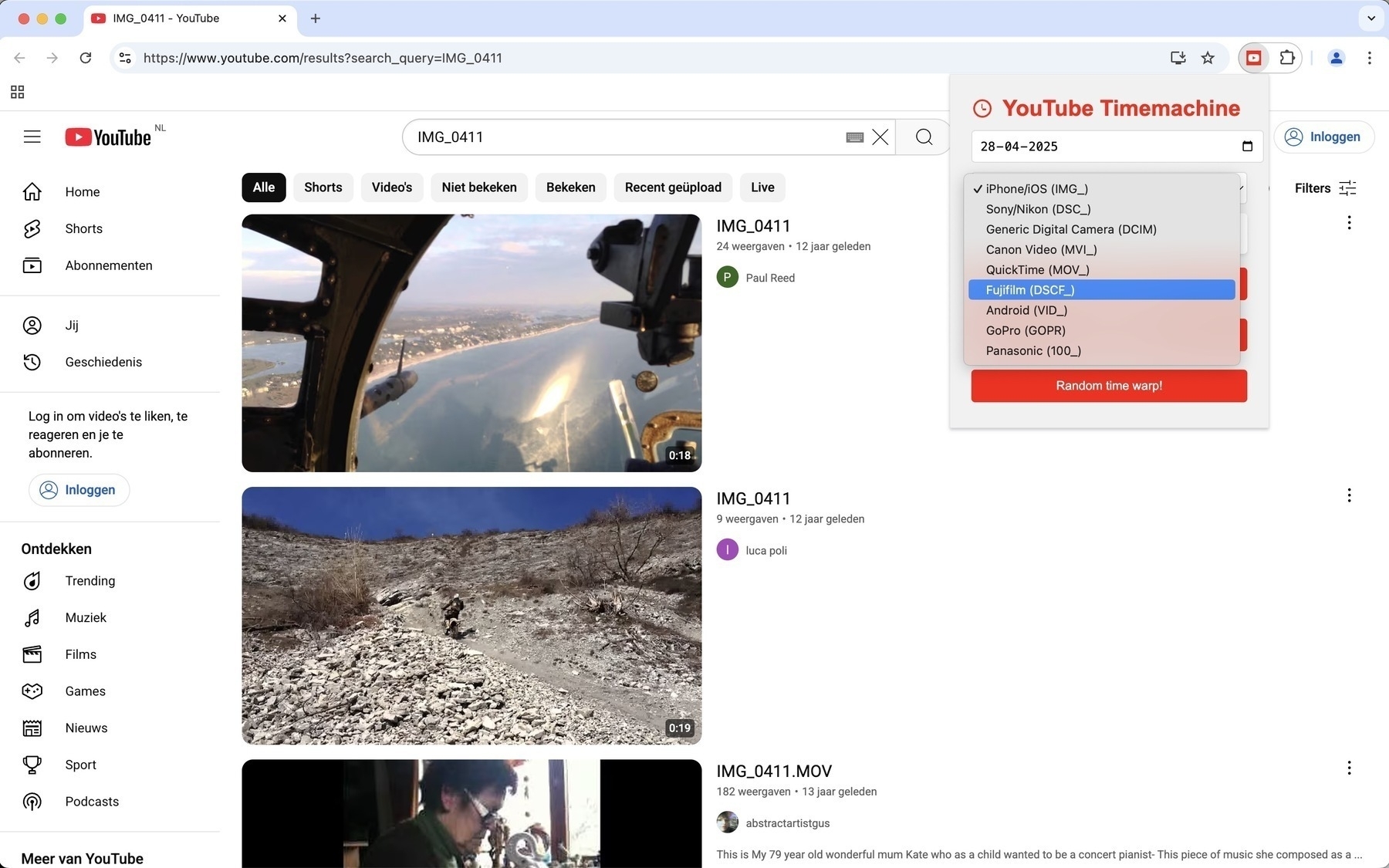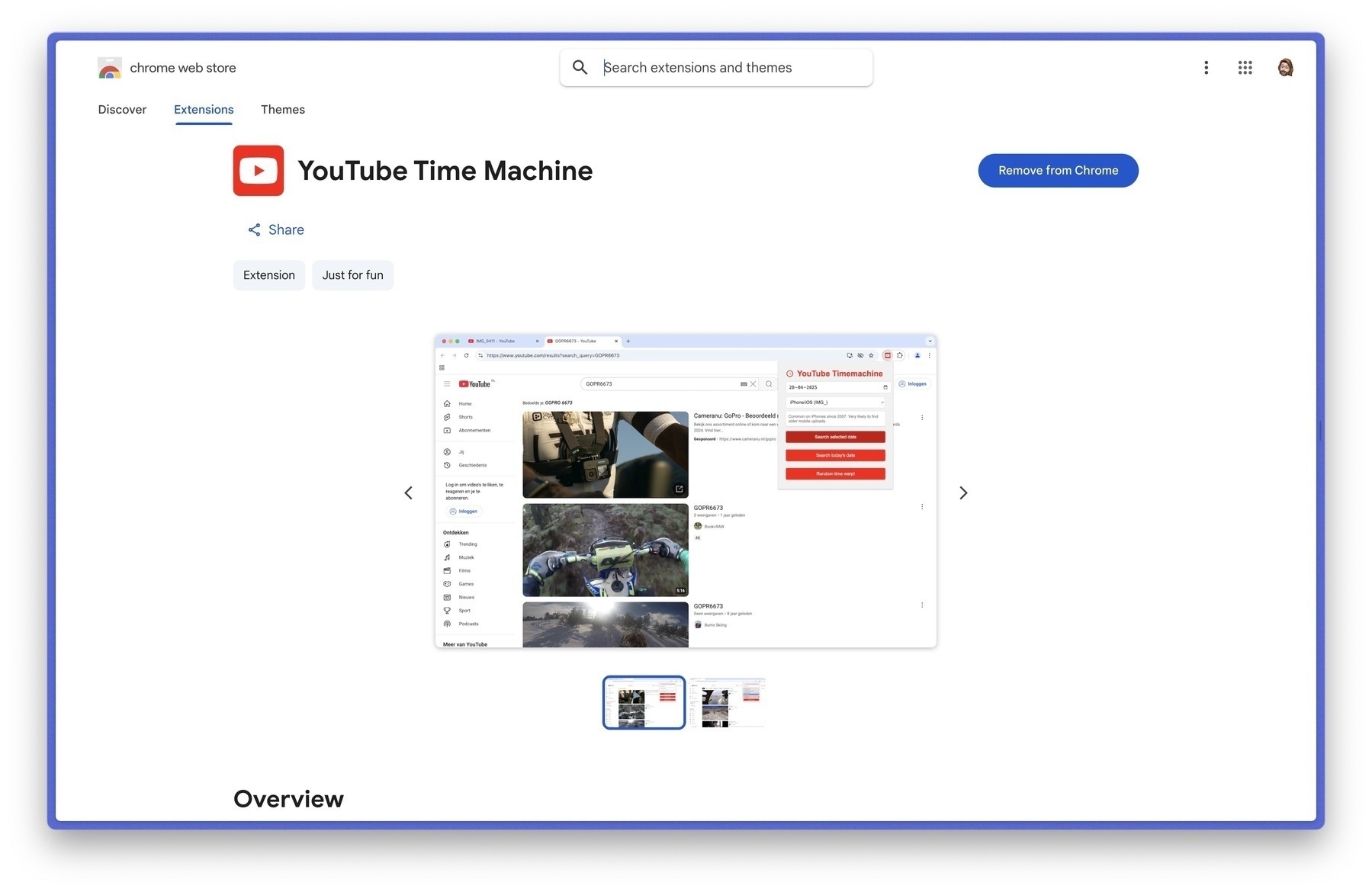The unseen YouTube: a tool to discover what the algorithm hides
tl;dr - You can find the Youtube Timemachine browser extension on the Chrome Web Store and Mozilla Add Ons.
How this happened
Did you know that the average YouTube video is viewed about 41 times? For a platform that seemingly features professional content creators and is the second most visited site after Google, this view count might seem disappointing. Or is something else going on? I’ll explain how this fact inspired me to create a browser extension that makes visible the videos that the YouTube algorithm keeps hidden.
The videos no one sees
I read an article on BBC “The hidden world beneath the shadows of YouTube’s algorithm”, written on the occasion of YouTube’s 20th anniversary. It provides a fascinating alternative perspective on the video platform. Not about the big channels, successful influencers, or the platform’s role in online conversations, but more about the essence of YouTube as a personal video platform. With billions of videos that have never been viewed or only rarely seen. Author Thomas Germain references a study by Ethan Zuckerman, among others. Zuckerman is the director of the Institute for Digital Public Infrastructure and primarily a blogger. The research shows that the median number of views for videos is just 41 times. This means most videos in the dataset have been viewed less than or equal to 41 times. Moreover, if your video has more than 130 views, you’re in the top 30% of the most popular content on the platform.
The findings of the study reminded me of a website that Germain also references, IMG_0001 by Riley Walz. Here you can find videos uploaded between 2009 and 2012 with iPhones that kept their standard file name, IMG_ followed by 4 numbers. These videos weren’t optimized for viewers but were meant to be quickly uploaded online to share with someone else. They are small snapshots of life, made public via the video service.
I realized there must be more videos from other cameras with a similar fixed structure in the filename and with few views on YouTube. I used to have a Sony Cybershot, which started file names with DSC_. There must be videos on YouTube in the format DSC_xxxx.
The idea
Then the idea came to me: Wouldn’t it be nice to have a browser extension to search through these videos? I proposed the idea to the AI app Openrouter, which allows me to automatically communicate with different models depending on the question. I had never made a browser extension before, so I had the service explain it step by step.
After 30 minutes, I had a local Chrome extension that did exactly what I wanted.

You choose a date and a camera model. The code converts the month and day into four digits. So today would be 0501, and it combines this with the chosen model in a search query for YouTube. Then it immediately shows the results in YouTube. Here you can see videos with the title DSC_0501 or here are videos made with a GoPro that have the filename GOPR1127. You can also select a random model and number with the Timewarp button. I chose to use a date as a starting point to generate the four digits. The extension doesn’t search for videos that were posted with specific models on specific dates. Is that unclear? Let me know.
The results are as surprising as in Germain’s article. There are dashcams with 15 views, a young skier with 2 views, or a performance by three young friends viewed only once. The calming waterfalls of Allagash, Maine. Some videos have never been viewed as you scroll through the list, some already have hundreds of views. But they are almost all videos free from call to actions, “like and subscribe” icons, and polished productions. They are glimpses into the daily lives of people around the world. They are videos that don’t have the pretension that the creator wants to be an influencer on social media. They are personal messages where the maker uses the tools at hand, like quickly making a video, uploading it, and sharing it privately.
YouTube likes to call itself the epicenter of popular culture and the new Hollywood. I prefer to see it as public infrastructure for people who want to tell a story, regardless of how many viewers they have.
How to make a browser extension
I had never made a browser extension before, so I first had Deepseek explain to me how they work. Then the model started creating the extension, constantly making adjustments based on my instructions. Finally, AI helped me understand how to publish a browser extension on the Chrome Web Store and Mozilla Add Ons.

Everything is relatively simple. You can find, download, and modify the complete code on Github.
With AI’s help, I went from idea to launch in less than 90 minutes. Most of the time was spent creating the right icons and filling out forms at Mozilla and Google to publish the extension. AI did all the basic work. I did review the code myself. Because it’s relatively simple, I can assess whether it does what it’s supposed to do. Some functions could possibly be more efficient and the CSS more streamlined, but I’m satisfied with it for now.
This was mainly a fun experiment to contribute to the internet that we sometimes forget amid the commercial bombardment we receive. The internet of small, personal interactions. Where you upload a video quickly to show someone. Not with the intention of becoming rich or gaining influence, but to share something. If I can make that more visible with this browser extension, then my goal has been achieved. I want to thank Thomas Germain for his article and the inspiration for the extension
Also interesting to know, I once published the 150th video ever on YouTube. That short minispeedway video from 20 years ago has only been viewed by 5,500 people. It’s a bit more edited and doesn’t have a standard camera filename, but still a piece of hidden YouTube history…